To start with some images (a picture tells a thousand words—but not if you are a philologist). This blog site does not allow individual notation of images, so I am adding a few notes right at the start:
a. loading of the ship in Fremantle.
b. At sea looking forward
c. At sea looking back.
d. The Bridge
e. Bridge GPS map display
f. Plan of the ship
g. The engine room (the chief engineer and Christine)
h. Our luxurious facilities
i. Pirate attack precautions
j. Deck plan
k. Stairwell from the top
l. Me at the bow!
m. Me at the controls !!

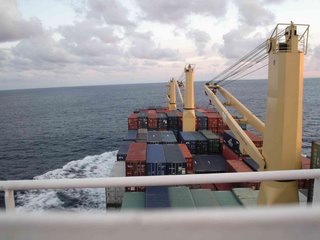
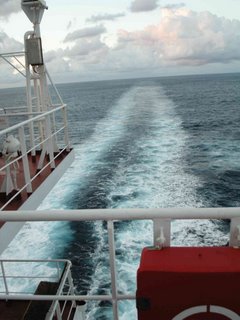
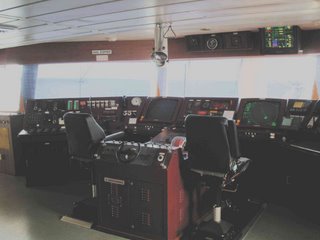


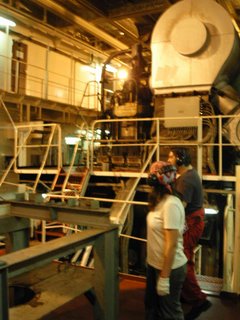
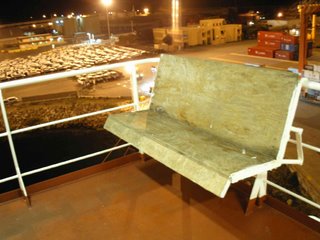

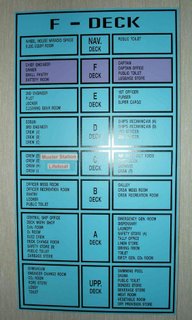
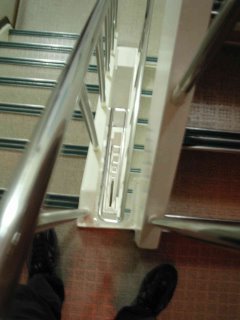

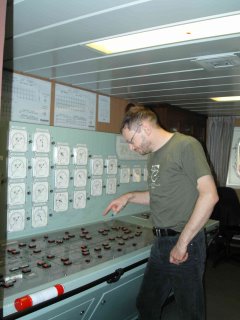
..............................................
short version:
Great fun, an interesting and dirty ship, which rolled a lot but no sea sickness, crew friendly, learnt much, would do again.
......................................................
long version:
Arrived! Safe and sound in Singapore after 7 days at sea!
The journey began in the port of Fremantle on the afternoon of Tuesday the 6th of June. I arrived at the shipping terminal eager and ready to depart on my bold adventure—and also carrying far too much luggage. A few moments later the Capt. also arrived at the terminal, climbed out of his taxi, along with my fellow passenger Christine from the UK (who has spent 2 years travelling! young people these days! no responsibility!), and introduced himself. We briefly chatted and then boarded the ship via the gangplank. I immediately hit my head on a low slung metal thing. A point I will mention again is that the ANL Esprit is a working ship, you will bump into things (and for those who do not know: a vessel under 12m in length is a ‘boat’, while anything larger is a ‘ship’, i.e. a lifeboat resides on a ship, also right is starboard, left is port, the sharp part of the ship is the bow, the blunt bit is the stern). After clambering on board I was then conveyed up a long stairwell, nearly to the top of the ship, to my cabin, and proceeded to settle myself into place.
To jump ahead I will tell you that the trip was fun and enjoyable. Travel by freighter is something everyone should do at least once in their life, however, it is a more challenging and markedly different mode of travel than that found on a luxurious cruise ship. A freighter is a rough environment. The engine is powerful and there is little attempt to make its operation pleasant to experience, it fills the peopled area of the ship with noise and vibration. Also a freighter is not concerned with a smooth voyage. Even in calm waters the ship yaws (side to side) and pitches (back to front) noticeably. Add all these factors together and the journey itself is not always the most pleasant part of the experience. If someone is prone to motion sickness I would not urge you undertake the long voyage across the Pacific.
For myself, I found the ship’s environment tolerable, and even a little bit of fun. During the first day we were shielded a little from the full force of the sea by the west coast of Australia, however, by the morning of the second day (8th June) we were sufficiently far from shore that the ship experienced some serious sea-induced movement. At first I found this motion ok, in fact, being rolled around my cabin, having to grab handholds and step lively, was fun, but by the second day the cumulative effect was beginning to take its toil. On the second and third day I was tired and sleepy most of the time. One of the crew told me that this was the first stage of seasickness, however, by day four I had returned to my customary good humour. Overall, it was not motion sickness which concerned me but a feeling of clumsiness—I felt compelled at times to grip both handrails while using the stairs, while crew members would zip (politely) past me at flank speed. I also had to think a little before moving around or picking things up—it was a little like being a teenager again (as a side note, for 2–3 days after landfall I kept unconsciously swaying in time to the non-existent ship. Even seasoned sailors need time to get their landlegs back).
It would be interesting to experience the full force of a wild sea. Just how much movement is there? Several crew members surprised me by revealing that they became seasick in very rough seas. I was also told that the trip between Fremantle and Singapore was relatively smooth, but across the Great Australian Bight (Adelaide to Perth) look out for storms and wild seas.
The most exciting part of the trip for me was the departure from Fremantle. While still in harbour I moved aorund the ship watching the loading of the cargo: big cranes, big trucks, big containers, lots of noise and action, all under bright lights—Great Stuff. At about 02.00 on the 7th June the ship was slowly turned by tug boat and pointed towards the harbour entrance. As we sailed away from Fremantle I could see the lights of Perth to starboard, and briefly see the island of Rottnest pass us by. All my life I have seen ships leave Fremantle and sail to ports unknown, now I was on one of those ships (though, I knew where I was going).
The ship itself, as I have already said, is a working ship—the doors are heavy, there are no lifts in the crew area, the exterior of the ship is covered with diesel soot, there is rust, the fittings are serviceable and also a little worn, the outside air is filled with the faint aroma of diesel fumes, there are areas where an unlucky slip and slide could carry someone off the boat into the deep, dark sea. There is also little in the way of onboard diversions: some old deckchairs, an indoor salt water pool, and a poorly equipped gym. The crew tend to work long hours and are diverted by their duties, passengers must make their own entertainment. I did try the pool, it is approximately 4m x 4m, filled with ocean water (which is very salty) and, as it is close to the engine, very noisy (in fact, if you put your head under water it is very, very noisy, with thumbs, bumps, and rattles). Not the best pool I have ever been in, but for the crew, after a hard days work, a good place to relax.
The ship is designed to carry cargo, the crew and passengers seem to be almost an afterthought. The front 4/5 of the ship is the container storage area, from hull to sky there are containers stacked on top of containers (each container has its own unique number). At the back of the ship is the people storage area, eight decks also stacked on top of each other. There is a hierarchy of placement, the bridge is at the top, the deck below has accommodation for the Capt, chief engineer, and the owner (in this case me!). Below this the cabins become smaller. There are also storage and workrooms. At the bottom is the engine room. My cabin consists of two main rooms: a lounge area with a couch, desk, table and chairs, TV, CD and DVD, plus a bedroom with an adjoining shower and toilet. All very comfy. To go between decks one must enter a stairwell and make one’s way up or down a often sometimes rolling set of stairs (14 steps per deck x 8 decks).
This ship can carry approximately 2,000+ containers, while the largest freighters can carry 8,000+ containers. A short lesson in ship economics: the Capt. told me that the daily rental (lease) charge for the Esprit was US$25–30k. This works out at less than $15 per day per container, thus to move a container from Perth to Singapore is less than $100. Freighter transport is economical (and with the bigger ships even more so).
Us passengers were given a tour of the engine room on the 9th of June. The ship’s engine is your basic diesel design, but big. It has 6 cylinders (the biggest ships have 14) which drive the propeller shaft. There is also a host of ancillary equipment, water purification, aircon, steering gear and so forth. One distinctive feature of the engine room is its temperature, it is hot, one temperature gauge read 50 degrees! Great if you are cruising the arctic circle, not so good in the tropics. One compensation is that the engine room, being at the bottom of the ship, experiences the least movement (while my cabin, being near the top, experiences far more). Some stats on the engine: it consumes 70 tonnes of fuel a day, the 28 day journey Singapore–Singapore requires ~1500 tonnes of fuel; the engine cylinder is 74cm x 2.5m (the biggest ship cylinders are 94cm across).
The other important area of the ship is of course the Bridge. It is here that the Capt. and the watch officers control the ship. From here you can see the ship’s surrounds and catch the latest info on the ship’s course and position. I went to the bridge several times a day to find out what was happening. The bridge consists of a control area, a navigation/chart room, a communications room, plus a look out area. The instrumentation on the bridge is not as hi-tech as I suspected it might be. There is a radar screen, a GPS based map display and lots of buttons and dials which control and indicate the myriad details of the ship’s operation. There are always two officers on duty on the bridge, though often one is below and ‘on call’ in case of need.
The crew is composed of Germans and Filipinos, in the main the officers are German and the enlisted personnel are Filipinos. I was told that to become an officer one must undertake an apprenticeship and then a four year University course. If one is a German citizen then the German government pays the bill, if not, then not. So Filipinos tend to take a 6 month course which allows then to carry out various support duties. The crew is not as ‘swasbuckling’ as the uninitiated might think. Most of the crew are married or have girlfriends, and are saving for something (remaining on a ship for 6 months is a great way not to spend money). One crewmember has been married only a few months and has so far spent very little time with his wife. Even though he does not talk about it, it is easy to see that this is difficult for him. The crew also change over with some frequency, at each port a few crew leave the ship and are replaced. One thing going for the crew is the demand for ship’s crew. There is a boom in shipping. The Capt. told me that his shipping line is adding 20 new ships to its existing fleet of 80. Most of these are destined for the far east.
I was surprised to learn that passengers on a freighter were not as rare as I had thought. The trip from Europe to Asia is the most common journey, with most freighters carrying a few passengers. I imagine that we provide some amusing diversion for the crew. The Capt. told me of one option for retired folk. Upon the payment of 25,000 Euros you become an ‘owner’ of the ship, this entitles you to rent the owner’s cabin for a mere 25 Euros a day. Many older European couples do just this and spend several months of the year sailing the world.
One pleasant surprise was the quality of the food on board, while not 5 star, it is good, varied, and plentiful. There is also a planned regularity to some of the ship’s diet. Certain days see certain foods served. For example, Thursday is icecream day, while Saturday has a tasty vegetarian soup. Part of this is to help keep the crew aware of the day of the week. Life at sea can easily become an unchanging routine, with each day the same as the previous and the next. On Sunday the passengers and officer’s gather for drinks. The Capt. told us that in days gone past the Capt. read from the good book, but now Sunday exists for a recreational drink.
Life on ship is not as exciting as romantic tradition would suggest. Most of the work is repetitive, and the ship sails a fixed route for extended periods of time. The big change over the last generation is the speed with which ships handle freight, it is now much faster than before. The downside (at least from the crew’s perspective) is the resultant short stay in port. For example, the Esprit was in Fremantle for only 12 hours or thereabouts. If a crew member has an 8 hour shift while in port there is little time to go onshore. It is possible to go for months without spending any lengthy time off the ship. As compensation for this the crew do have a sense of camaraderie and a rather jovial approach to their life at sea. It was in fact this camaraderie that made the trip worthwhile.
What made the single largest impression was the informality of the crew. The Capt. and officers wore shorts and T-shirts, and frequently got their hands dirty. The Filipinos were equally friendly, and asked me about vegetarianism, Australia, and Australian working visas (the obtaining of).
The main diversion on each trip is a BBQ! On this voyage it was the evening of Friday the 9th. The principal component was a pig on a spit, along with squid, prawns and other nautical niceties. For Christine and myself the cook kindly prepared skewers of veggies (which looked rather lonely surrounded as they were by stacks of dead and eviscerated animal). The BBQ lasted until 23.00, fairly late for the hard working ship’s crew.
Pirates: something out of Hollywood and history, but still present in some parts of the world. As we journed through the straights between Java and Sumatra, there was a possibility that some enterprising free-market entrepreneurs might decide to redistribute the wealth by boarding our ship. On the bridge there are lists of pirate activities, and warnings of potential problems, there is usually one or two a day, however, while there is a possibility of an attack it is slight. To protect against this threat we will be locking all exterior doors and unused cabin doors, ‘projectors’ (hoses with holes) will be strung along the side of the ship to deter pirates, and deck lights will shine down onto the water.
The last day on board was spent twisting and turning around the islands big and small which lead to Singapore. In these confined and shallow waters there are small fishing boats and huge supertankers. At this stage of our journey the officers on watch are just a little busier than on the open sea. Our approach to Singapore harbour began at around 04.00 on the 12th June. A pilot came on board and in conjunction with the Capt. docked the boat. On land again! After one last breakfast on the Esprit I left the ship, with some regret, for the last time and began my time in Singapore!
a. loading of the ship in Fremantle.
b. At sea looking forward
c. At sea looking back.
d. The Bridge
e. Bridge GPS map display
f. Plan of the ship
g. The engine room (the chief engineer and Christine)
h. Our luxurious facilities
i. Pirate attack precautions
j. Deck plan
k. Stairwell from the top
l. Me at the bow!
m. Me at the controls !!













..............................................
short version:
Great fun, an interesting and dirty ship, which rolled a lot but no sea sickness, crew friendly, learnt much, would do again.
......................................................
long version:
Arrived! Safe and sound in Singapore after 7 days at sea!
The journey began in the port of Fremantle on the afternoon of Tuesday the 6th of June. I arrived at the shipping terminal eager and ready to depart on my bold adventure—and also carrying far too much luggage. A few moments later the Capt. also arrived at the terminal, climbed out of his taxi, along with my fellow passenger Christine from the UK (who has spent 2 years travelling! young people these days! no responsibility!), and introduced himself. We briefly chatted and then boarded the ship via the gangplank. I immediately hit my head on a low slung metal thing. A point I will mention again is that the ANL Esprit is a working ship, you will bump into things (and for those who do not know: a vessel under 12m in length is a ‘boat’, while anything larger is a ‘ship’, i.e. a lifeboat resides on a ship, also right is starboard, left is port, the sharp part of the ship is the bow, the blunt bit is the stern). After clambering on board I was then conveyed up a long stairwell, nearly to the top of the ship, to my cabin, and proceeded to settle myself into place.
To jump ahead I will tell you that the trip was fun and enjoyable. Travel by freighter is something everyone should do at least once in their life, however, it is a more challenging and markedly different mode of travel than that found on a luxurious cruise ship. A freighter is a rough environment. The engine is powerful and there is little attempt to make its operation pleasant to experience, it fills the peopled area of the ship with noise and vibration. Also a freighter is not concerned with a smooth voyage. Even in calm waters the ship yaws (side to side) and pitches (back to front) noticeably. Add all these factors together and the journey itself is not always the most pleasant part of the experience. If someone is prone to motion sickness I would not urge you undertake the long voyage across the Pacific.
For myself, I found the ship’s environment tolerable, and even a little bit of fun. During the first day we were shielded a little from the full force of the sea by the west coast of Australia, however, by the morning of the second day (8th June) we were sufficiently far from shore that the ship experienced some serious sea-induced movement. At first I found this motion ok, in fact, being rolled around my cabin, having to grab handholds and step lively, was fun, but by the second day the cumulative effect was beginning to take its toil. On the second and third day I was tired and sleepy most of the time. One of the crew told me that this was the first stage of seasickness, however, by day four I had returned to my customary good humour. Overall, it was not motion sickness which concerned me but a feeling of clumsiness—I felt compelled at times to grip both handrails while using the stairs, while crew members would zip (politely) past me at flank speed. I also had to think a little before moving around or picking things up—it was a little like being a teenager again (as a side note, for 2–3 days after landfall I kept unconsciously swaying in time to the non-existent ship. Even seasoned sailors need time to get their landlegs back).
It would be interesting to experience the full force of a wild sea. Just how much movement is there? Several crew members surprised me by revealing that they became seasick in very rough seas. I was also told that the trip between Fremantle and Singapore was relatively smooth, but across the Great Australian Bight (Adelaide to Perth) look out for storms and wild seas.
The most exciting part of the trip for me was the departure from Fremantle. While still in harbour I moved aorund the ship watching the loading of the cargo: big cranes, big trucks, big containers, lots of noise and action, all under bright lights—Great Stuff. At about 02.00 on the 7th June the ship was slowly turned by tug boat and pointed towards the harbour entrance. As we sailed away from Fremantle I could see the lights of Perth to starboard, and briefly see the island of Rottnest pass us by. All my life I have seen ships leave Fremantle and sail to ports unknown, now I was on one of those ships (though, I knew where I was going).
The ship itself, as I have already said, is a working ship—the doors are heavy, there are no lifts in the crew area, the exterior of the ship is covered with diesel soot, there is rust, the fittings are serviceable and also a little worn, the outside air is filled with the faint aroma of diesel fumes, there are areas where an unlucky slip and slide could carry someone off the boat into the deep, dark sea. There is also little in the way of onboard diversions: some old deckchairs, an indoor salt water pool, and a poorly equipped gym. The crew tend to work long hours and are diverted by their duties, passengers must make their own entertainment. I did try the pool, it is approximately 4m x 4m, filled with ocean water (which is very salty) and, as it is close to the engine, very noisy (in fact, if you put your head under water it is very, very noisy, with thumbs, bumps, and rattles). Not the best pool I have ever been in, but for the crew, after a hard days work, a good place to relax.
The ship is designed to carry cargo, the crew and passengers seem to be almost an afterthought. The front 4/5 of the ship is the container storage area, from hull to sky there are containers stacked on top of containers (each container has its own unique number). At the back of the ship is the people storage area, eight decks also stacked on top of each other. There is a hierarchy of placement, the bridge is at the top, the deck below has accommodation for the Capt, chief engineer, and the owner (in this case me!). Below this the cabins become smaller. There are also storage and workrooms. At the bottom is the engine room. My cabin consists of two main rooms: a lounge area with a couch, desk, table and chairs, TV, CD and DVD, plus a bedroom with an adjoining shower and toilet. All very comfy. To go between decks one must enter a stairwell and make one’s way up or down a often sometimes rolling set of stairs (14 steps per deck x 8 decks).
This ship can carry approximately 2,000+ containers, while the largest freighters can carry 8,000+ containers. A short lesson in ship economics: the Capt. told me that the daily rental (lease) charge for the Esprit was US$25–30k. This works out at less than $15 per day per container, thus to move a container from Perth to Singapore is less than $100. Freighter transport is economical (and with the bigger ships even more so).
Us passengers were given a tour of the engine room on the 9th of June. The ship’s engine is your basic diesel design, but big. It has 6 cylinders (the biggest ships have 14) which drive the propeller shaft. There is also a host of ancillary equipment, water purification, aircon, steering gear and so forth. One distinctive feature of the engine room is its temperature, it is hot, one temperature gauge read 50 degrees! Great if you are cruising the arctic circle, not so good in the tropics. One compensation is that the engine room, being at the bottom of the ship, experiences the least movement (while my cabin, being near the top, experiences far more). Some stats on the engine: it consumes 70 tonnes of fuel a day, the 28 day journey Singapore–Singapore requires ~1500 tonnes of fuel; the engine cylinder is 74cm x 2.5m (the biggest ship cylinders are 94cm across).
The other important area of the ship is of course the Bridge. It is here that the Capt. and the watch officers control the ship. From here you can see the ship’s surrounds and catch the latest info on the ship’s course and position. I went to the bridge several times a day to find out what was happening. The bridge consists of a control area, a navigation/chart room, a communications room, plus a look out area. The instrumentation on the bridge is not as hi-tech as I suspected it might be. There is a radar screen, a GPS based map display and lots of buttons and dials which control and indicate the myriad details of the ship’s operation. There are always two officers on duty on the bridge, though often one is below and ‘on call’ in case of need.
The crew is composed of Germans and Filipinos, in the main the officers are German and the enlisted personnel are Filipinos. I was told that to become an officer one must undertake an apprenticeship and then a four year University course. If one is a German citizen then the German government pays the bill, if not, then not. So Filipinos tend to take a 6 month course which allows then to carry out various support duties. The crew is not as ‘swasbuckling’ as the uninitiated might think. Most of the crew are married or have girlfriends, and are saving for something (remaining on a ship for 6 months is a great way not to spend money). One crewmember has been married only a few months and has so far spent very little time with his wife. Even though he does not talk about it, it is easy to see that this is difficult for him. The crew also change over with some frequency, at each port a few crew leave the ship and are replaced. One thing going for the crew is the demand for ship’s crew. There is a boom in shipping. The Capt. told me that his shipping line is adding 20 new ships to its existing fleet of 80. Most of these are destined for the far east.
I was surprised to learn that passengers on a freighter were not as rare as I had thought. The trip from Europe to Asia is the most common journey, with most freighters carrying a few passengers. I imagine that we provide some amusing diversion for the crew. The Capt. told me of one option for retired folk. Upon the payment of 25,000 Euros you become an ‘owner’ of the ship, this entitles you to rent the owner’s cabin for a mere 25 Euros a day. Many older European couples do just this and spend several months of the year sailing the world.
One pleasant surprise was the quality of the food on board, while not 5 star, it is good, varied, and plentiful. There is also a planned regularity to some of the ship’s diet. Certain days see certain foods served. For example, Thursday is icecream day, while Saturday has a tasty vegetarian soup. Part of this is to help keep the crew aware of the day of the week. Life at sea can easily become an unchanging routine, with each day the same as the previous and the next. On Sunday the passengers and officer’s gather for drinks. The Capt. told us that in days gone past the Capt. read from the good book, but now Sunday exists for a recreational drink.
Life on ship is not as exciting as romantic tradition would suggest. Most of the work is repetitive, and the ship sails a fixed route for extended periods of time. The big change over the last generation is the speed with which ships handle freight, it is now much faster than before. The downside (at least from the crew’s perspective) is the resultant short stay in port. For example, the Esprit was in Fremantle for only 12 hours or thereabouts. If a crew member has an 8 hour shift while in port there is little time to go onshore. It is possible to go for months without spending any lengthy time off the ship. As compensation for this the crew do have a sense of camaraderie and a rather jovial approach to their life at sea. It was in fact this camaraderie that made the trip worthwhile.
What made the single largest impression was the informality of the crew. The Capt. and officers wore shorts and T-shirts, and frequently got their hands dirty. The Filipinos were equally friendly, and asked me about vegetarianism, Australia, and Australian working visas (the obtaining of).
The main diversion on each trip is a BBQ! On this voyage it was the evening of Friday the 9th. The principal component was a pig on a spit, along with squid, prawns and other nautical niceties. For Christine and myself the cook kindly prepared skewers of veggies (which looked rather lonely surrounded as they were by stacks of dead and eviscerated animal). The BBQ lasted until 23.00, fairly late for the hard working ship’s crew.
Pirates: something out of Hollywood and history, but still present in some parts of the world. As we journed through the straights between Java and Sumatra, there was a possibility that some enterprising free-market entrepreneurs might decide to redistribute the wealth by boarding our ship. On the bridge there are lists of pirate activities, and warnings of potential problems, there is usually one or two a day, however, while there is a possibility of an attack it is slight. To protect against this threat we will be locking all exterior doors and unused cabin doors, ‘projectors’ (hoses with holes) will be strung along the side of the ship to deter pirates, and deck lights will shine down onto the water.
The last day on board was spent twisting and turning around the islands big and small which lead to Singapore. In these confined and shallow waters there are small fishing boats and huge supertankers. At this stage of our journey the officers on watch are just a little busier than on the open sea. Our approach to Singapore harbour began at around 04.00 on the 12th June. A pilot came on board and in conjunction with the Capt. docked the boat. On land again! After one last breakfast on the Esprit I left the ship, with some regret, for the last time and began my time in Singapore!
Comments